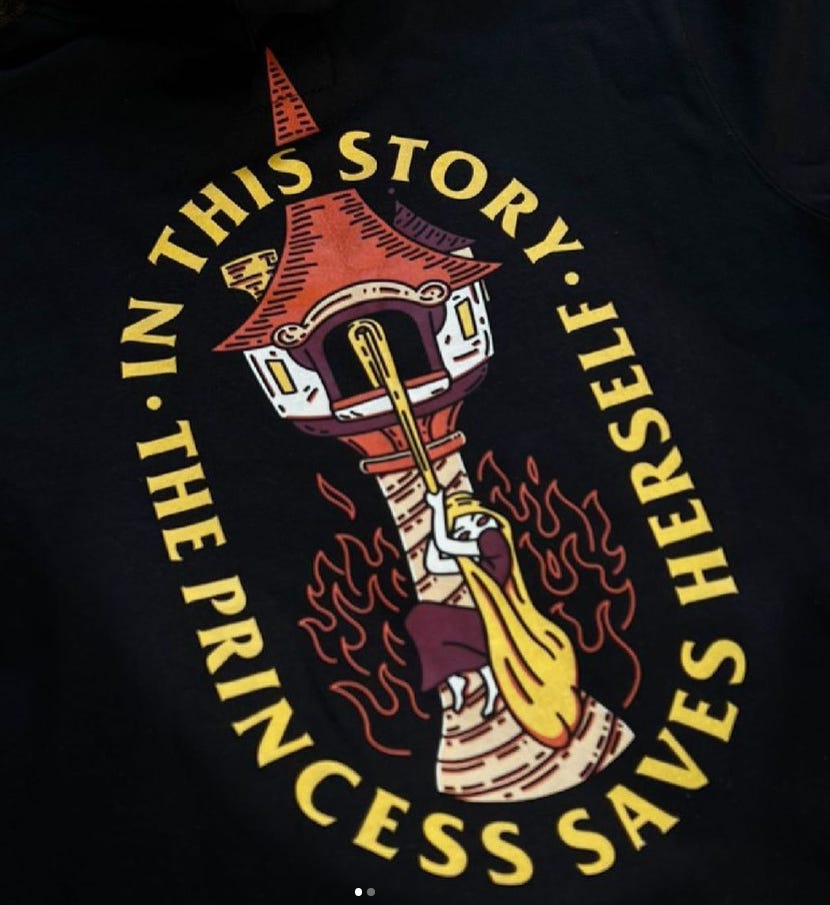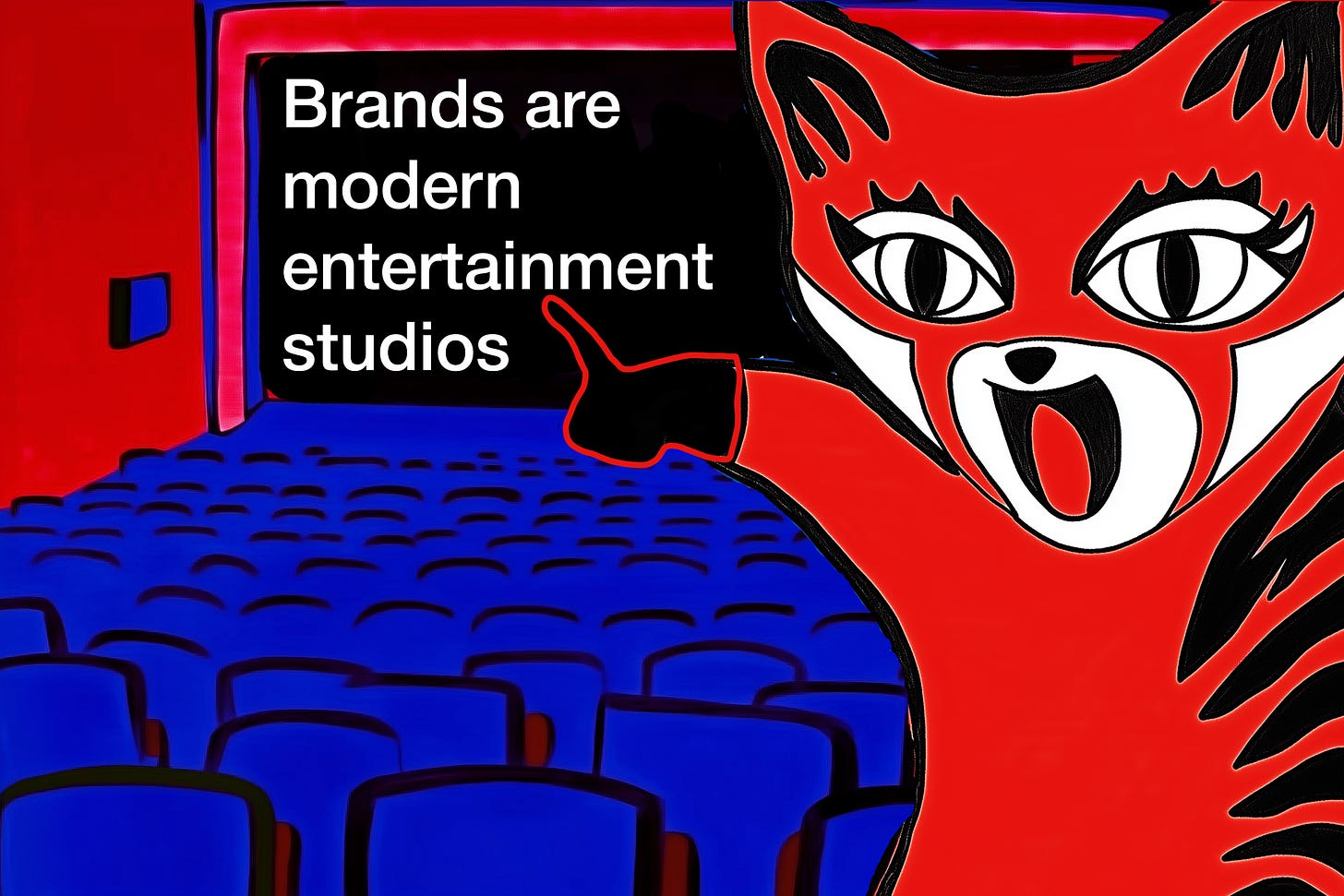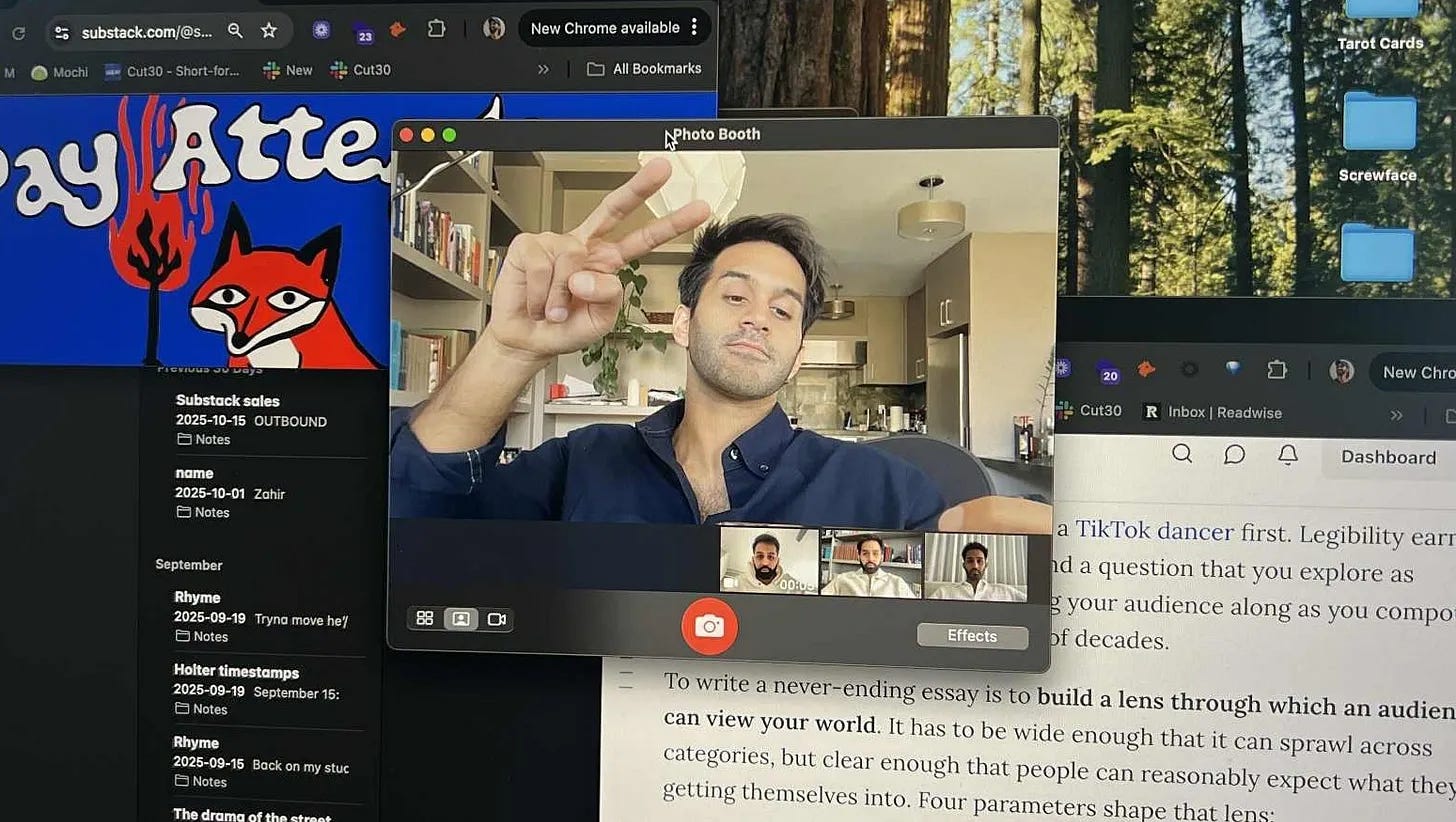Everything’s Entertainment (Donald Trump Voice)
Pay Attention: Exploring how brands and startups can become media companies.

It has never been easier to make new things, and it has never been harder to get people to pay attention.
Everyone knows that creators are becoming businesses, but the reality is that businesses also need to become creators. Brands and tech companies have the opportunity to become modern entertainment studios. If you look at the shows, stunts, and box-office hits of 2025, it’s clear that we’re entering a renaissance of branded entertainment.1
The first time I tried to get a job at Shopify, the ecommerce company, I knew so little about it that I referred to it in a cold DM as “Spotify,” the music streaming service. I had just turned twenty years old, a sweaty, eager undergrad, and all I knew was that something interesting was happening in “tech,” and I had to be a part of it.2
When I eventually started working there in 2017, one of my first sales calls was with what I thought to be a frantic woman, telling me all about this thing she was selling called a “fidget spinner.” The store was on track to eclipse my annual salary in that month alone, and her gadgetry only plunged deeper into my heart when I later found out that I was actually speaking to a fourteen-year-old boy. His trick was simple: he made really funny Instagram Ads. I never ended up closing that deal, but it irreversibly changed how I saw the spread of ad inventory across my social feeds. I, an internet-native child of forums, MMORPGs, and Twitter, naively didn’t realize that people were actually clicking ads.
I tucked away the idea that you could entertain your way into building a real business, and I ended up finding some crumb of success with a brand in maybe the most competitive category out there: women’s apparel. The business, in hindsight the embarrassing sidequest of a 20-something-year-old degenerate trying to make a buck online, found its edge in producing entertainment around a good core story: No Prince Charming Apparel, “Don’t we deserve some new fairytales?”
There was nothing special about the clothing itself — the brand was effectively a media company whose product was a physical manifestation of its narrative. We were genuinely proud of the videos we produced, the UFC fighters who wore our clothes unsolicited, and the thousands of loving messages we got for the brand story. My brother, sister-in-law, and I cycled something like a million dollars through the business over the next few years. Every dollar that didn’t go to inventory went right back into producing entertaining Instagram Ads, in an attempt to hit the sort of scale I whiffed in that early sales call. But alas, as Apple’s pixel changes in 2020 sent Meta’s ad business into a multi-year spiral, we lived and died by the rising cost of customer acquisition. As the death knell tolled for the end of our ecommerce dream, my chronic onlineness saved me,3 and I ended up getting a job at a small startup named Substack.
My degeneracy on Instagram Ads had taught me that entertaining media was a means to an end — to help me better anonymously shill women’s clothing. Substack had a different vision, where entertaining media was the end — a world where the media itself was worth paying for. I spent five years working behind the scenes on a new independent media ecosystem where the underlying business model could support good work, and I had a front-row seat working directly with publishers as they went from $0 to millions in annual recurring subscriptions. I’m incredibly bullish on how that ecosystem will evolve from here.4
Brands are modern entertainment studios
Now, on the other side, I see these two worlds converging in branded entertainment, an old phenomenon ripe for a return:
The easiest days of direct response ads are over. Social ads are more expensive than ever, consumers are getting smarter about them, and everyone is extra opinionated on what good marketing looks like.
Creator economics. We now have a class of potential showrunners who are format-fluent, have direct distribution, and can actually influence purchasing decisions. Many of them have been pursuing social media full-time for over a decade, and want to move beyond being “YouTubers” or “creators”. They’re ready to take bigger creative swings and need bold financiers.
YouTube just won’t stop growing. Connected TVs are taking over living rooms, more people now watch YouTube on TV than on mobile, and YouTube gets more TV watch time than all the major streamers. Long-form drives real loyalty.
Some brands have already gone through the painful process of setting up their own entertainment arms, but there is now far more scaffolding in the form of specialized third party branded entertainment studios.
In a world where products are more easily commodified, in commerce and software, brands and tech companies need to realize that everything’s entertainment. Attention has long been the global reserve currency, and incremental product advantages will matter less and less as every company becomes a media company. But don’t take my word at face value: top YouTube talent managers are launching their own content studios, Crocs signed Anthpo to create a branded stunt, Duolingo learned from Mr. Beast and launched an animated show, F1 started a YouTube show with Amelia Dimoldenberg, B2B SaaS companies are doing marketing stunts, a screentime app created its own edutainment creator, Ridge gave MKBHD an equity stake in the business to accelerate into a creator-first brand, a rent-to-rewards tech company launched a short-form TV show, Amazon Prime is collaborating on the spinoff to Gymnasium’s short-form series “Boy Room”.
The future of this newsletter
All of this brings me to my overwhelming question: how can brands and tech companies become modern entertainment studios?
I’m confident that the best brands and tech companies of tomorrow will be the ones who build entertainment properties that start compounding today. I’ve lived at the intersection of these worlds for the last ~decade — between my time at Shopify and Substack, I’ve worked directly with something like >5,000 internet businesses to help define their voice online. But the attention games of the internet are evolving every day, and the businesses that win will be the ones who build for the long-term, not the ones who get caught up in day-to-day growth hacks.
If your brand or startup is building its own media properties, for $12/month, I’m confident this newsletter will make you better at your job.
Your subscription supports your career in three ways:
Weekly case studies on what’s working. I’ll highlight and critique a stunt, show, or other branded media property, so that you can remix what’s already working elsewhere.5
Insights on building your own branded entertainment property. On top of the case studies, paying subscribers will get a weekly post with frameworks, guides, essays on relevant trends, and anything else I feel may help you build a media company. If the case studies are an outline of what’s working today, then think of these as an outline of what will work tomorrow.
Me fucking around and finding out. In obnoxious tech parlance, I will forever be an “operator.” I’m going to try some dumb stuff on the internet6 to test/prove whether my theories actually work. Some stunts will land and others will not, but either way, paying subscribers will get to read about what I did and how they might apply it to their career. And of course, let me know if you and your team would like to work on a stunt together <3
If you lead content at a growth-stage company and use just one new approach to start or scale your media property, the weekly newsletter pays for itself. Change is afoot on the internet, and it’d be wise to pay attention.
(I love my trickster fox stealing fire from the gods <3)
Content that puts your product at the heart of its narrative. It’s not a product placement where you get vibe points for a cameo inside an unrelated story, or a brand deal where you take a loan on an influencer’s reputation via a thirty second shoutout. It’s IP that acts as a vehicle to specifically tell your brand story, all without feeling like a hard sell.
When I was eleven years old, all of my friends got together to start a rock band, and they asked me if I wanted to be the lead singer or the business manager. I chose manager. My entire life, for better or worse, has been downstream of that decision. The pursuit of commercializing art has since found its way into my life over and over and over again. And so when I see the absolute slop that some brands are producing, it’s infuriating that people who are so well positioned to take creative risks are doing everything but.
So bullish, in fact, that I quit my job *at* Substack to go full-time on my *own* Substack. I really do buy Chris Best’s theory on “The two futures of media,” and in many ways this entire project is an exploration of how businesses can position themselves for both of those futures.
It almost feels naive to say, but internet marketing is unfathomably broad. The tech industry is only now just discovering how to orchestrate user-generated videos at scale, but ecommerce operators started running this playbook 2 years ago, and they, in turn, learned it from Andrew Tate back in 2022. These sorts of grifty marketing campaigns aren’t interesting to me, but my point is that it’s helpful to have someone at the frontiers of the internet to bring back tactics from all sorts of industries.
My most schizo lore is that I think there’s a 30% chance I coined tech’s phrase de jour, “You Can Just Do Things”. If you search Twitter there were almost no results for that phrase in 2023, then I went viral with that screenshot essay in Feb 2024, snagged the trademark, and then Sam Altman ended up tweeting it and taking all the credit smh.








Randa misled me about the subject of this publication. Please process my refund.
Can’t wait to follow along!!! Go Shai go!